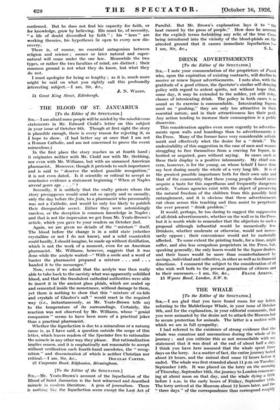THE BLOOD OF ST. JANUARIUS
[To the Editor of the SPECTATOR.]
am afraid some people will be misled by the mischievous statements in Mr. Edward Clodd's letter on this subject in your issue of October 9th. Though at first sight the story is plausible enough, there is every reason for rejecting it, as I hope to show. (I had better say at once that I am not a Roman Catholic, and am not concerned to prove the event miraculous.) In the first place the story reaches us at fourth hand ; it originates neither with Mr. Clodd nor with Mr. Stebbing, nor even with Mr. Williams, but with an unnamed American pharmacist.. Moreover, though it pretends to such importance and is said to " deserve the widest possible recognition," it is not even dated. Is it scientific or critical to accept as conclusive evidence a statement beginning " When at Naples several years ago . . ." ?
Secondly, it is unlikely that the crafty priests whom the story presupposes would send out so openly and so casually, only the day before the festa, to a pharmacist who presumably was not a Catholic, and would be only too likely to publish their disreputable secret. Either they were astonishingly careless, or the deception is common knowledge in Naples ; and that is not the impression we got from Mr. Yeats-Brown's article, which you gave to your readers on October 2nd.
Again, we are given no details of the " mixture " itself. The blood before the change is in a solid state (whether crystalline or not I do not know), and a solid counterfeit could hardly, I should imagine, be made up without distillation, which is not the work of a moment, even for an American pharmacist. Mr. Williams, however, suggests that it was done while the acolyte waited—" With a smile and a word of banter the pharmacist prepared a mixture . . . and . . . handed it to the messenger."
Now, even if we admit that the acolyte was then really able to take back to the sacristy what was apparently solidified blood, and that the fraudulent cathedral authorities were able to insert it in the ancient glass phials, which are sealed up and cemented inside the monstrance, without damage to them, yet there is nothing to show that this " mixture of ox-bile and crystals of Glauber's salt " would react in the required way (i.e., instantaneously, as Mr. Yeats-Brown tells us) to the temperature of its surroundings. Certainly, the reaction was not observed by -Mr. Williams, whose " genial companion " -seems to have been more of a practical joker
than a practical pharmacist.. -
Whether the liquefaction is due to a miraculous or a natural cause is, as I have said, a question outside the scope of this letter, which leaves readers of the Spectator free to rationalize the miracle in any other way they please. But rationalization implies reason, and it is emphatically not reasonable to accept without verification such fourth-hand anecdotes, the recog- nition " and dissemination ofwhich is neithei• Christian nor






















































 Previous page
Previous page